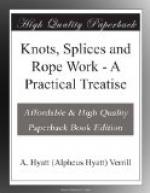[Illustration: FIG. 97.—Rose lashing.]
[Illustration: FIG. 98.—Deadeye lashing.]
[Illustration: FIG. 99.—Loop lashing.]
[Illustration: FIG. 100.—Belaying-pin splice.]
The necklace tie is useful in holding two ropes, hawsers, or timbers side by side (Fig. 101). The lashing is passed around and around the two objects to be joined and the ends secured by a square knot passed around the band lengthwise. The close band is used for the same purposes as the last and is made in the same manner, but the ends are fastened by drawing through beneath the turns (Fig. 102).
[Illustration: FIG. 101.—Necklace tie.]
[Illustration: FIG. 102.—Close band.]
End pointings are very useful as well as ornamental, for while an ordinary seizing or whipping will prevent the strands from unravelling, the ends are broad and clumsy and oftentimes are too large to pass through a block or eye large enough for the rest of the rope. The ordinary way of pointing a rope is to first whip as described (Fig. 4), and then unlay the end as for the Flemish eye. Take out about two-thirds of the yarns and twist each in two. Take two parts of different yarns and twist together with finger and thumb, keeping the lay on the yarn and thus forming left-handed stuff known as “nettles.” Comb out the rest of the yarn with a knife, leaving a few to lay back upon the rope. Now pass three turns of twine like a timber-hitch tightly around the part where the nettles separate and fasten the twine, and while passing this “warp” lay the nettles backward and forward with each turn. The ends are now whipped with twine or yarn and finally “snaked,” which is done by taking the end under and over the outer turns of the seizing alternately. If the rope is small a stick is often put in the upper part to strengthen it or the tip maybe finished with a small eye. If properly done a pointed rope is very handsome and appears as in B, Fig. 103. Another simple way of finishing a rope end is to seize the end, as at A, Fig. 104, and open out the strands, bring the strands back alongside the rope, and whip the whole (Fig. 105).
[Illustration: FIG. 103.—Pointing a rope.]
[Illustration: FIG. 104.—Ending rope.]
[Illustration: FIG. 105.—Ending rope.]
Splicing is, in many cases, more useful and better than tying or bending ropes together and a good splice always looks neater and more ship-shape than a knot, no matter how well-made it may be. A person familiar with splicing will turn in a splice almost as quickly as the ordinary man can tie a secure knot, and in many cases, where the rope must pass through sheaves or blocks, a splice is absolutely necessary to fasten two ropes or two parts of a parted rope together. The simplest of all splices is known as the “Short Splice” (Fig. 106). This is made as follows: Untwist the ends of the rope for a few inches and




